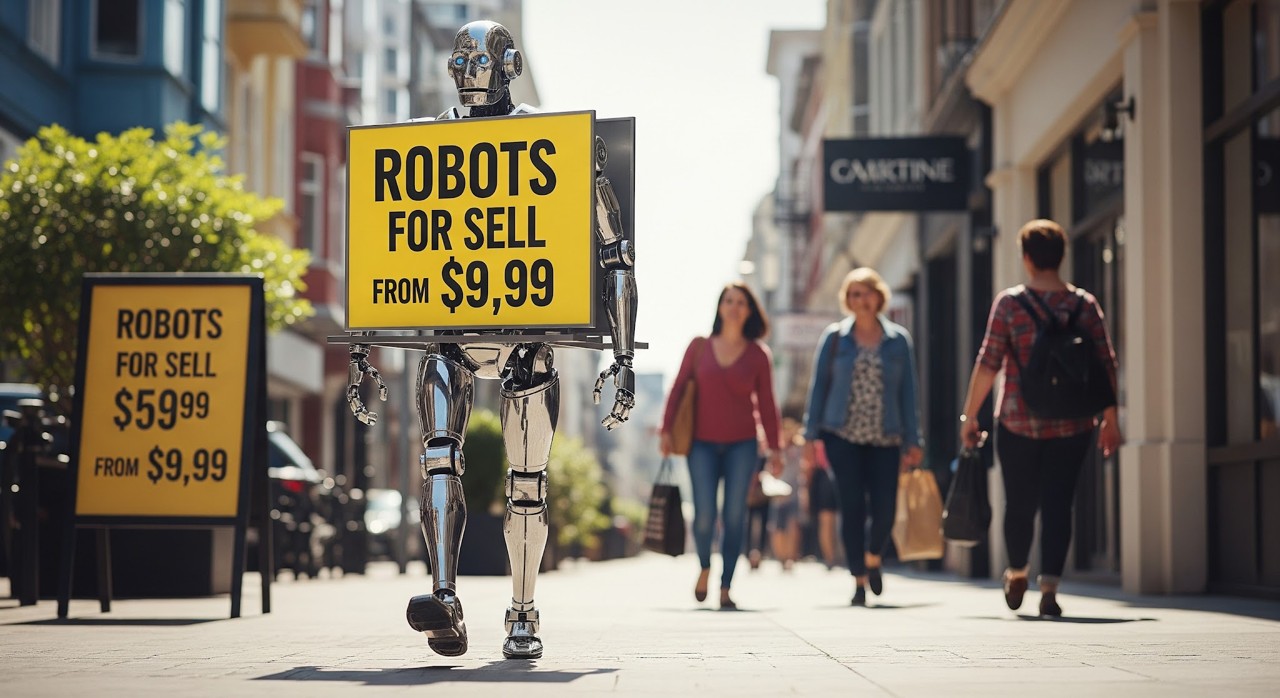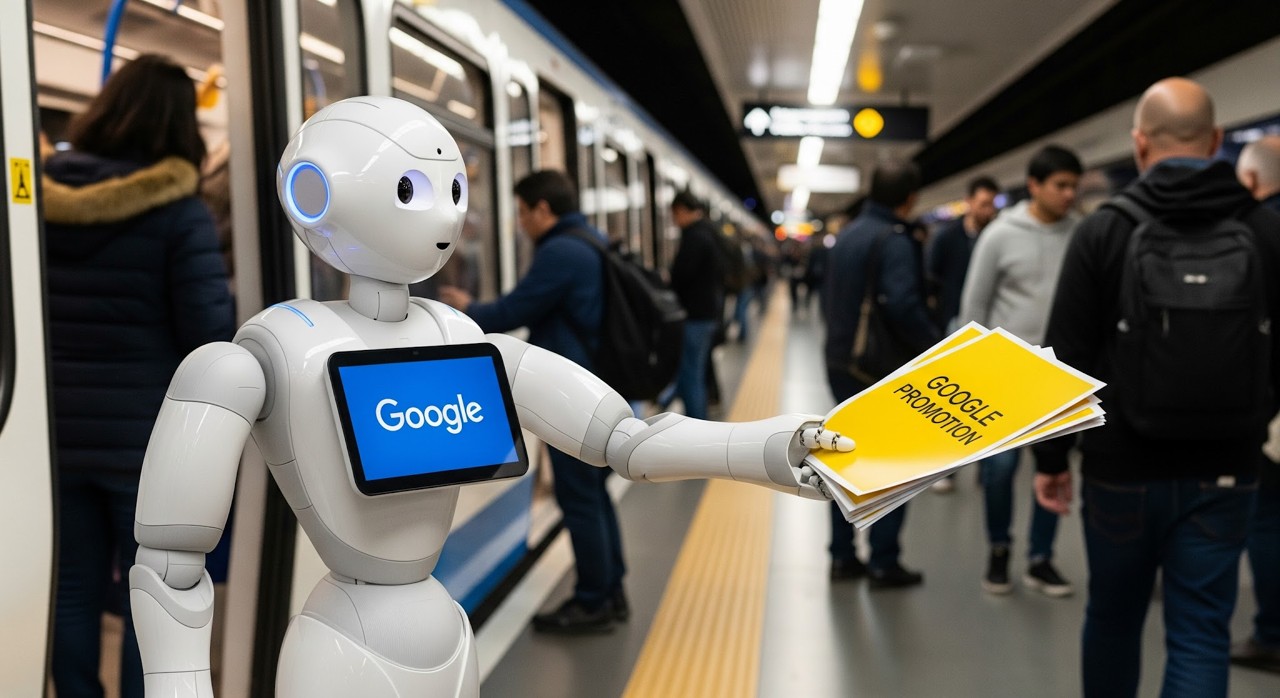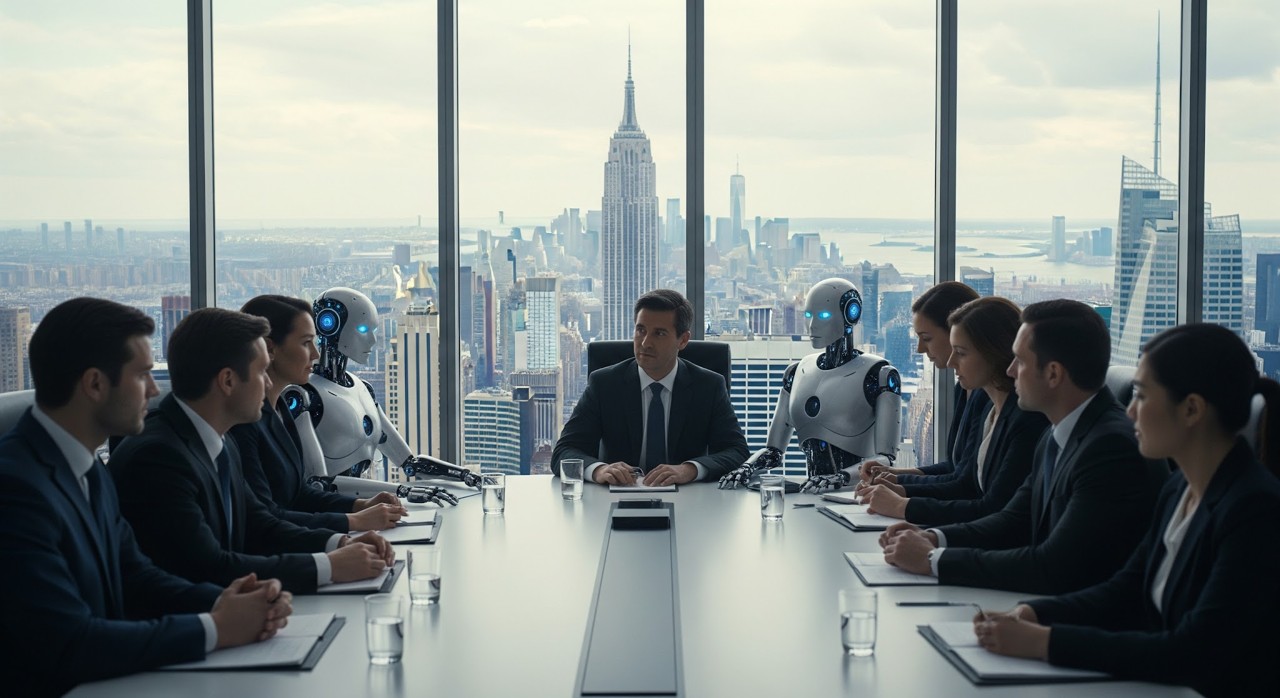20 min to read
By Bruno Gavino, CEO, Codedesign
Digital marketing landscape is on the cusp of its most profound transformation yet. At Codedesign, a data-driven digital marketing agency, we've been closely tracking the commitment from major tech giants – Meta, Google, Amazon, TikTok, and Snapchat – to fully AI-driven ad generation and automated audience targeting by 2026. This isn't a distant future; it's a near-term reality that will fundamentally reshape how we, and our clients, approach digital marketing and business strategy.
As a founder who's been in the trenches, I see this not as a threat, but as an unparalleled opportunity. Our experience at Codedesign has shown us that preparedness is key. This article will unpack the strategic implications of this shift, providing senior marketers, growth-stage founders, and curious peers with evidence-based observations and actionable strategies – strategies we're already implementing for our clients – to not just survive, but thrive in this AI-first advertising era. We’ll explore how this automation will transform creative workflows, necessitate robust AI governance, and redefine competitive advantage, consistently highlighting how Codedesign's digital capabilities can uniquely empower businesses. We’re moving into an age where AI-driven ad generation becomes the default, demanding a holistic understanding of its impact on digital marketing and business strategy, and we're here to guide you through it.
The Dawn of Autonomous Advertising
The commitment from major platforms to fully AI-driven ad generation by 2026 signals a paradigm shift. This isn't merely about AI assisting human marketers; it's about AI taking the lead, automating everything from creative development to audience targeting and budget optimization. At Codedesign, understanding the scope of these ambitions is the first step in preparing our clients' businesses.

Meta's Vision: From URL to Campaign Autonomy
Meta’s vision for 2026 is perhaps the most ambitious in the realm of AI-driven ad generation. By this time, businesses are expected to simply input a product image and a budgetary goal, and Meta's AI will autonomously generate the entire campaign. This includes creating imagery, video, and text, as well as handling audience targeting and budget allocation recommendations. The system will dynamically personalize ads in real-time, showing different versions to users based on their engagement patterns and demographic data. Meta CEO Mark Zuckerberg has articulated a future where businesses will only need to specify their objectives and connect payment methods, with Meta’s systems handling creative, targeting, and measurement entirely.
This move towards full automation builds directly on Meta’s existing AI-powered systems, such as Advantage+ campaigns. These tools already demonstrate how machine learning can optimize targeting and budget allocation more effectively than manual human management. Notably, Meta has progressively reduced detailed targeting options not due to technical limitations, but because their AI systems consistently produce superior results when unconstrained by human-defined audience parameters. This philosophical shift underscores Meta’s confidence in machine learning’s ability to identify optimal audiences more accurately than traditional advertiser assumptions.
This profound shift means that the traditional skill sets focused on granular campaign setup, A/B testing, and manual optimization will potentially drastically diminish. If Meta's vision fully materializes, the need for human expertise in these operational tasks will either disappear or be radically transformed. We recognize the logical consequence is a significant impact on marketing team structures and the urgent need for marketers to adapt their capabilities, shifting their focus from repetitive, data-driven tasks to strategic oversight and AI interaction.
Meta’s ability to achieve such automation is directly tied to its vast, proprietary datasets and its unparalleled control over its ad delivery ecosystem. Meta's AI is trained on analysis of billions of successful ad campaigns and on successful Meta ads. This enormous data advantage, combined with the simplified "URL and budget" input model , creates a powerful network effect and potential vendor lock-in. If the AI handles all decision-making, brands may lose visibility into the underlying logic, leading to increased dependence and a potential lack of actionable information beyond the reported results. This illustrates a direct link between Meta's data advantage and its ability to centralize control over ad operations.
While this highly automated approach promises radical simplification and accessibility for smaller businesses that may lack extensive resources or dedicated marketing teams , it simultaneously presents a critical trade-off. Larger brands, accustomed to granular control and nuanced creative direction, may find themselves "relinquishing control" and facing "black-box decisions" regarding creative rationale and targeting logic. Currently we advise our clients that the balance between ease of use and maintaining brand autonomy will become a key strategic consideration. Businesses must consciously weigh the benefits of simplified operations against the potential loss of granular control and transparency, making strategic choices about their level of AI adoption.

Beyond Meta: Google, Amazon, and TikTok's AI Roadmaps
Google is equally committed to integrating AI into its advertising ecosystem, reimagining ads and shopping experiences. Their focus is on creating ads that are less intrusive and more helpful for customer discovery. Generative AI capabilities are being deeply integrated into Search and YouTube, with ads expanding into new formats like AI Overviews and AI Mode. Google is enhancing its creative tools with advanced models like Veo (for video) and Imagen (for images), making image-to-video transformation and AI outpainting available within Google Ads and Merchant Center. Furthermore, their Product Studio offers a free suite of AI tools for optimizing visuals, generating custom lifestyle scenes, and creating videos, with a new "generated for you" feature proactively suggesting campaign concepts, featured products, and discounts. Google is also introducing Smart Bidding Exploration to find less obvious, high-performing searches and new agentic capabilities specifically designed to help smaller businesses adapt and succeed with less effort.
Amazon’s AI strategy in advertising is heavily focused on streamlining product content creation. Their Amazon Ads Video Generator is a prime example, capable of converting a single product image into an 8-21 second video ad with photorealistic motion in under five minutes. This tool supports multiple video variations per product, generates realistic action scenes, and allows for multi-scene sequencing, text overlays, music, and logo placement. It's fully integrated with Amazon Ads and Sponsored Brands and is free for authenticated sellers and advertisers. Beyond this, Amazon offers Nova Reel via AWS Bedrock, a developer tool designed for generating narrative video sequences up to two minutes, signaling a move into long-form, AI-generated storytelling for enterprises.
TikTok is rapidly expanding its generative AI features through its Symphony suite for advertisers. This includes robust image-to-video and text-to-video support, alongside AI avatars that can even hold up or wear products. These tools enable the creation of fast, low-cost, and scroll-stopping content without the need for actors or elaborate sets , a development that could significantly disrupt the traditional influencer economy.
Snapchat is actively integrating AI into its ad operations to enhance efficiency and performance. They are introducing AI-powered smart bidding, enabling advertisers to set a target cost-per-action that Snap's system will automatically work to achieve. Additionally, their "Smart Budget" feature allows for automatic spending allocations to the highest-performing ad sets, maximizing outcomes. Snapchat is also expanding its Sponsored Snaps, including new creator-based options that add a personal, authentic touch to ads.
The widespread adoption of generative AI for ad creation, targeting, and optimization across all major platforms (Meta, Google, Amazon, TikTok, Snapchat) indicates that AI capabilities are rapidly becoming a baseline expectation, not a competitive differentiator. This means that the competitive advantage will shift from simply having AI tools to mastering their inputs, understanding their outputs, and strategically integrating them into broader marketing efforts. At Codedesign, we see this convergence of similar AI functionalities being rolled out by different major platforms as a clear sign that AI is no longer a niche or experimental tool but a fundamental, ubiquitous component of the digital advertising landscape. The logical next step in competitive strategy is therefore not about if a business uses AI, but how well it uses it.
AI’s ability to generate multiple creative variations quickly and at minimal cost directly leads to an explosion in the sheer volume of ad content. Amazon's tool creates videos in "under 5 minutes" , and TikTok's tools enable "fast, low-cost, scroll-stopping content". This unprecedented speed and cost-efficiency will inevitably lead to marketers producing a significantly higher quantity of ad variations. Managing and optimizing such a massive volume manually would be impossible, thus creating a direct need for AI-driven testing and optimization methodologies to effectively manage, analyze, and prevent creative fatigue across campaigns.
At Codedesign, we understand this shift means that the competitive edge for marketing professionals and agencies will dramatically move towards strategic brand thinking, compelling storytelling, and guiding platform strategy with human nuance and deep market understanding. The warning that "Creative agencies are at risk, especially those producing basic product videos, social ads, or performance content. The work is now free, fast, and built into the platform" clearly outlines a necessary evolution for marketing professionals and agencies, where value shifts from repeatable tasks (now automated) to higher-order strategic and creative functions that require unique human capabilities.

Reshaping Creative: AI as Co-Pilot, Not Replacement
The rise of AI in AI-driven ad generation doesn't spell the end of human creativity; rather, it redefines it. Our role as marketers shifts from manual execution to strategic oversight, enabling us to achieve unprecedented levels of efficiency and creative exploration, fundamentally impacting digital marketing and business strategy.
Augmenting Creativity: Efficiency and Exploration
AI is profoundly transforming creative workflows by streamlining arduous and time-consuming tasks (like all the images in this article would take months to create), thereby freeing human creative professionals to focus on more strategic and innovative endeavors. For example, Adobe utilized AI to significantly reduce content production time for Black Friday campaigns, allowing their staff to reallocate their efforts towards strategic work. Similarly, Tripadvisor leverages AI to streamline analytics and media planning, enabling marketers to prioritize strategy and innovation. McKinsey research further emphasizes this point, indicating that the fundamental redesign of workflows has the biggest impact on an organization's ability to realize EBIT (Earnings Before Interest and Taxes) gains from AI adoption.
Generative AI tools are emerging not as replacements for human creatives, but as powerful "creative sparring partners." They help designers and strategists move beyond obvious ideas, test a wider array of directions, and uncover unexpected creative possibilities. Tools like Midjourney, Stable Diffusion, and Runway can facilitate rapid sketching, exploration of tonal variations, and pushing the boundaries of what’s possible during early brand concepting stages. At Codedesign, we believe the true value lies in helping us move "wider and deeper," enriching the creative process and elevating the end result, rather than simply accelerating production.
As AI automates the generation of creative content, the human role within creative workflows transitions from being a primary content producer to a critical curator, editor, and strategic guide. This demands a refined skillset focused on prompt engineering, critical evaluation of AI outputs, and strategic thinking to ensure brand alignment, distinctiveness, and overall campaign effectiveness. The consistent message from various sources about AI streamlining tasks and freeing up time for strategic work directly implies that the nature of creative work is changing from hands-on production to high-level direction. If AI is doing the heavy lifting of generation, humans must then apply judgment, refine, select, and ensure the output aligns with the brand's overarching strategy, thus shifting the emphasis to curation and strategic oversight.
For a deeper dive into how AI streamlines marketing operations, reach out to our Marketing Team.

The Indispensable Human Layer: Authenticity and Nuance
While AI excels at data processing, pattern recognition, and rapid generation, it currently cannot replicate the full spectrum of human creativity. Human marketers bring essential qualities such as emotional intelligence, empathy, originality, and the unique ability to build genuine connections with audiences. They possess an innate understanding of cultural nuances and can craft messages that elicit authentic emotional responses, an area where AI still struggles.
With AI-generated content, there is a tangible risk that creative work could become indistinct, generic, or feel "algorithmic rather than alive". To counteract this, human oversight is absolutely essential. At Codedesign, we emphasize that marketers must act as curators, editors, and strategic guides, ensuring that AI-augmented work consistently reflects a brand's unique values, authentic voice, and distinct point of view. This human layer is indispensable for achieving "distinctiveness at scale" in an increasingly automated landscape.
The performance comparison between AI-generated and human-created content presents a nuanced picture. While some studies indicate that AI-generated visual ads are perceived positively by consumers and even preferred in certain instances , human artwork is consistently assigned a higher monetary value. Crucially, studies focusing on ad copy suggest that human-written ads often outperform AI in terms of accuracy, contextual relevance, and persuasive ability, particularly for sensitive topics like those in the pharmaceutical industry.
One specific study found that human-written ads achieved 45.41% more impressions and 60% more clicks than their AI-generated counterparts, boasting a higher Click-Through Rate (CTR) of 4.98% compared to AI's 3.65%, and a lower Cost Per Click (CPC).
This suggests that while AI excels at optimization, the human touch remains vital for true resonance and impact. At Codedesign, we leverage AI for efficiency and scale, but always ensure a robust human-in-the-loop process to maintain this critical emotional connection and brand authenticity
The ongoing discussion around AI's capacity for "creativity" forces us, as marketers and business leaders, to fundamentally re-evaluate what true creativity means in a digital age. Is it solely about generating novel outputs, or is it inextricably linked to the intent, emotional depth, and lived human experience behind those creations? The question of whether AI is truly "creative" and its potential lack of "human experience, emotions and intentionality" represents a profound philosophical shift. This will influence how brands perceive, value, and invest in creative talent and processes moving forward, extending beyond mere marketing performance to the very definition of creative work and its inherent value. Our team believe true creativity will always be rooted in human insight.

The Imperative of AI Governance and Brand Safety
As AI-driven ad generation takes on a more autonomous role in advertising, the stakes for AI governance and brand safety escalate dramatically. Without clear frameworks and vigilant oversight, brands risk not only severe reputational damage but also significant regulatory penalties and a profound erosion of consumer trust, directly impacting their digital marketing and business strategy.
Building Robust AI Governance Frameworks (on constant update)
It is imperative for marketers to prioritize ethical AI deployment and establish robust governance frameworks. These frameworks are crucial for ensuring that AI-driven marketing builds consumer trust, promotes fairness, and maintains transparency. Without deliberate and comprehensive governance, the unchecked use of AI risks eroding consumer trust, severely damaging brand reputation, and inviting stringent regulatory scrutiny. McKinsey’s research strongly supports this, indicating a direct correlation between CEO oversight of AI governance and higher self-reported bottom-line impact from an organization’s generative AI use.
An effective AI governance framework is a structured system comprising policies, ethical principles, and legal standards designed to guide the development, deployment, and monitoring of artificial intelligence. Its essential components include:
|
Component |
Description |
Value |
|
Clear Ethical Principles |
Define core values (fairness, privacy, transparency) to guide AI strategy and vendor selection. |
This component is foundational for any responsible AI implementation. Without clearly articulated ethical principles, AI adoption can become directionless or even harmful. It provides a moral compass for all subsequent decisions, ensuring that the technology serves the brand's broader ethical stance, which in turn is crucial for building and maintaining consumer trust. It moves beyond mere compliance to proactive ethical leadership. At Codedesign, we help clients define these principles, ensuring their AI strategy aligns with their core brand values. |
|
Robust Data Governance |
Implement strict data quality, consent management, and security protocols; conduct regular audits to ensure compliance and reduce risks. |
The effectiveness and ethical soundness of AI are directly tied to the quality and ethical sourcing of its training data ("Good data = Good AI" ). Poor or biased data leads to inaccurate or discriminatory outputs. Furthermore, data privacy and security are paramount for maintaining consumer trust and adhering to increasingly strict regulatory requirements. This component ensures that the raw material feeding AI systems is sound, secure, and ethically obtained. Our data-driven approach at Codedesign emphasizes the integrity and ethical handling of data. |
|
Explainable AI (XAI) Tools |
Utilize AI models and platforms that provide interpretable outputs and clear reasoning for their decisions. |
Many AI algorithms can operate as "black boxes," making it difficult to understand why a particular decision was made or why an ad performed in a certain way. For marketers, understanding these rationales is crucial for continuous learning, strategic optimization, and accountability. XAI fosters transparency, which is a key driver of consumer trust and helps in diagnosing issues like bias. At Codedesign, we advocate for transparency in AI outputs to empower our clients. |
|
Continuous Monitoring for Bias |
Employ bias detection tools and diverse datasets to proactively identify and mitigate unfair or discriminatory outcomes. |
AI systems, if not carefully managed, can inadvertently perpetuate or amplify existing societal biases present in their training data. This poses a significant ethical and reputational risk for brands. Proactive and continuous monitoring ensures fairness, prevents alienating segments of the target audience, and helps maintain brand integrity and social responsibility. This is a critical area where Codedesign provides ongoing oversight. |
|
Cross-Functional Collaboration |
Foster strong collaboration between marketing, legal, data science, and compliance teams for holistic oversight and alignment. |
AI in marketing is not a siloed function; it touches multiple critical domains within an organization, including creative, data, legal, and ethics. A fragmented or siloed approach will inevitably lead to gaps in oversight, compliance issues, and missed strategic opportunities. Collaboration ensures that all relevant perspectives are considered, leading to a more robust, compliant, and ultimately more effective AI strategy. At Codedesign, we facilitate this collaboration to ensure a unified AI strategy. |
|
Employee Training & AI Literacy |
Develop comprehensive AI literacy, ethical awareness, and prompt engineering skills across all teams involved in AI-driven marketing. |
Despite AI's advancements, the human element remains critical for strategic direction and nuanced decision-making. Employees need to understand AI's capabilities and limitations, how to interact with AI tools effectively (e.g., prompt engineering), and the ethical implications of their use. This empowers them to leverage AI responsibly and strategically, ensuring that human insight guides the technology rather than being supplanted by it. Codedesign offers training and guidance to upskill client teams in AI literacy. |
Navigating Brand Safety and Suitability in an AI-First World
Traditionally, brand safety has focused on protecting a brand's reputation by preventing ad placements next to harmful or inappropriate content, such as hate speech, graphic violence, or misinformation. However, the conversation has significantly evolved to encompass "brand suitability," which adopts a more nuanced and proactive approach. Suitability focuses on positive alignment, actively choosing media contexts that reinforce the brand message and align with a company's values and audience expectations, rather than merely avoiding risk.
AI plays a dual role in this evolving landscape: it is both a potential source of risk (e.g., synthetic content, deepfakes) and a powerful tool for risk mitigation and content screening. AI significantly supports brand safety and suitability through:
-
Natural Language Processing (NLP) and Large Language Models (LLMs): These advanced tools analyze text content not just for the presence of keywords, but for their tone, context, intent, and sentiment. They can detect subtle threats like sarcasm, coded speech, or nuanced misinformation, and adapt to evolving language patterns. This allows for more precise filtering, reducing unnecessary media loss while maintaining brand protection.
-
Computer Vision: As the advertising landscape shifts towards video-first platforms, computer vision becomes critical. It scans images and video frames for explicit, violent, or unsafe visuals, and can identify inappropriate logos, symbols, or scenes that purely text-based analysis might miss. This adds a crucial layer of visual intelligence to brand safety strategies.
-
Machine Learning: Acting as the unifying element, machine learning recognizes patterns across diverse content types, platforms, and campaigns. It continuously improves over time through feedback loops and user input, making systems more accurate and less dependent on rigid, static rules. This capability is vital for scaling media investments without losing control, by identifying patterns in campaign performance and flagged risks, leading to fewer surprises and less media waste.
-
Application in Programmatic Advertising: AI tools are seamlessly integrated into programmatic advertising workflows at two critical stages:
-
Pre-bid Filtering: Before an ad is placed, AI evaluates the content of the page, app, or stream in milliseconds. If the environment is deemed safe and suitable, the demand-side platform (DSP) proceeds; if flagged as risky, the bid is skipped, preventing misplacement.
-
Post-bid Audits: After ad delivery, AI systems review placement locations, logging any issues and feeding that data back into the model to improve future targeting and prevent repeat mistakes, ensuring continuous learning and improvement.
-

Despite these significant advancements, AI remains far from infallible in brand safety. Key challenges include:
-
Interpretation of Nuance: AI models often struggle to distinguish between irony, parody, satire, or complex cultural references due to their inherent lack of lived experience and nuanced contextual understanding. This can lead to misclassification or overcorrection, particularly in global campaigns with varying cultural sensitivities.
-
Timeliness: AI systems may not respond quickly enough to fast-evolving content, such as rapidly shifting news cycles, emerging slang, or overnight memes. Without frequent updates and human oversight, AI can lag behind contextual shifts, leaving brands exposed.
-
Deepfakes and Synthetic Content: The increasing sophistication of generative AI tools makes harmful or misleading synthetic content, including deepfakes, progressively harder for AI to detect and verify authenticity across various formats. This is an evolving arms race.
-
False Positives vs. False Negatives: There is a persistent trade-off. Overly cautious AI systems can block safe, high-quality content, unnecessarily limiting campaign reach and performance. Conversely, if filters are too loose, harmful or inappropriate material can slip through, causing brand damage. Achieving the right balance requires more than just automation, relying heavily on feedback loops, audits, and human calibration.
Despite AI’s advancements, human expertise remains central to effective brand safety and suitability. AI flags potential risks, but trained professionals are indispensable for making the final decisions on complex edge cases, ambiguous satire, subtle misinformation, or regional sensitivities. They possess the critical ability to incorporate brand-specific context and make final calls on controversial content, understanding tone, cultural dynamics, and long-term brand impact. This human layer is increasingly vital as generative content becomes more sophisticated and nuanced. AI agents can be designed by advertisers to be bespoke and explainable, learning what works and doesn't work for a specific brand's unique needs.
The strategic shift from a purely "brand safety" mindset (focused on blocking dangerous content) to a more sophisticated "brand suitability" approach (actively seeking positive alignment with brand values) signifies a maturing approach to media placement. AI enables the scale required for this nuanced analysis, but human judgment is paramount in defining and continuously refining the "suitable" parameters. This is a clear trend in the industry, indicating that brands are adopting a more proactive and strategic posture, where ad placement actively contributes to brand building and reputation, rather than just mitigating negative exposure. AI provides the tools for this scale, but human marketers define the strategic intent.
Just as established brands have comprehensive style guides and brand books for human creatives, the advent of widespread AI-driven ad generation necessitates the development of explicit "Brand AI Guidelines." These guidelines will dictate acceptable tone, visual style, content types, and ethical boundaries for AI-generated ads, becoming a critical component of a brand's asset libraries and overall AI governance system [User Query]. The risk of AI "misinterpret[ing] the brand tone, or generate[ing] visuals that fall flat" strongly implies that without clear, formalized guidelines specifically for AI, the risk of off-brand or inconsistent content increases significantly. Therefore, creating these "Brand AI Guidelines" becomes a necessary step for maintaining brand integrity and consistency in an automated creative environment. Codedesign assists clients in developing and implementing these crucial guidelines.

Performance and Competitive Edge in the AI Era
The integration of AI into digital marketing is not merely about efficiency; it's a fundamental driver of performance and a critical determinant of competitive advantage. Businesses that strategically leverage AI for ad generation, targeting, and optimization are already seeing significant gains across key metrics, reshaping the landscape of digital marketing and business strategy.
Quantifiable Performance Gains with AI
The data unequivocally demonstrates that AI-optimized advertising campaigns consistently outperform traditional approaches across a range of critical metrics. Organizations implementing AI in their advertising campaigns report an average 76% increase in ROI compared to traditional methods. This dramatic improvement stems from AI's ability to identify high-value audience segments and allocate budgets more efficiently.
Furthermore, AI-optimized campaigns show an average 30% reduction in customer acquisition costs across industries. By precisely identifying which prospects are most likely to convert, AI prevents wasteful ad spend on low-probability targets. Advertising campaigns utilizing AI for creative optimization also demonstrate 40% higher conversion rates compared to non-AI campaigns.
The impact on audience engagement is equally compelling. AI-powered dynamic creative optimization delivers a 257% increase in click-through rates compared to standard creatives. This substantial improvement is a direct result of algorithms generating thousands of creative variations and showing the optimal version to each user in real-time. AI-optimized campaigns also remain effective three times longer before experiencing creative fatigue, extending the useful life of advertising assets through constant refinement and variation. E-commerce advertisers using AI bidding and budget allocation report 28% higher Return on Ad Spend (ROAS) compared to manual campaign management, as algorithms can make micro-adjustments to bids thousands of times daily based on performance data.
Beyond direct campaign metrics, AI automation tools save marketing teams an average of 59% of time previously spent on campaign management tasks. This efficiency allows creative professionals to focus on strategy rather than execution details. Moreover, AI-optimized ad placements result in 35% higher brand recall rates compared to traditional media planning methods, by identifying optimal contexts for ad delivery.
Case studies further illustrate these benefits:
-
Stitch Fix: Leveraged AI to personalize customer experiences, resulting in a 45% increase in first-time customer acquisition and a 21% reduction in customer acquisition costs over 12 months.
-
Sephora: Employed an interactive advertising approach driven by AI, leading to an 87% increase in consumer engagement with digital ads and a 31% higher conversion rate from ad to purchase.
-
Toyota: Used AI to analyze vast consumer data to predict car-buying cycles, resulting in a 53% improvement in qualified lead generation and a 21% increase in dealership visits attributed to digital advertising.
-
BMW: Utilized generative AI tools to produce localized ad content, achieving faster turnaround times across regions, significant cost savings on design and localization, and a boost in reach and engagement due to more relevant, tailored content.
-
Nutella: Used an AI algorithm to generate 7 million unique packaging designs, which sold out quickly, demonstrating AI's potential in product design and brand engagement.
-
J.P. Morgan Chase: Partnered with Persado to use AI for copywriting, finding that AI-generated copy resulted in higher click-through rates and a 450% increase in ad click-through rates.
The consistent and significant performance improvements across ROI, CAC, conversion rates, and engagement demonstrate that AI is not just an incremental improvement but a transformative force in digital advertising. This widespread success across diverse industries and campaign types indicates that AI-driven advertising is rapidly becoming the new benchmark for effective marketing. The cumulative evidence of AI's performance benefits establishes a clear imperative for businesses to integrate and optimize their AI capabilities to remain competitive.

Redefining Competitive Advantage
In this rapidly evolving landscape, competitive advantage is being redefined. It’s no longer just about having a great product or a strong brand; it’s about how effectively a business can leverage AI to understand, reach, and engage its target audience at scale. This is where Codedesign's expertise provides a crucial edge.
-
Data-Driven Decision Making: AI’s ability to process and analyze massive amounts of data quickly and accurately is a game-changer. It uncovers patterns and trends that would be missed by traditional analysis methods, providing real-time or near-real-time insights into market dynamics, competitor strategies, and consumer preferences. This capability allows marketers to make more informed, proactive, and strategic decisions, accelerating revenue growth and unlocking greater value from marketing technologies. At Codedesign, this is fundamental to our data-driven digital marketing strategy.
-
Hyper-Personalization at Scale: AI enables hyper-personalization by analyzing consumer behavior, preferences, and past interactions to predict content or offers that will resonate with individual users. This allows for real-time adjustments to customer experiences, tailoring campaigns from product recommendations to targeted advertisements with ever-growing accuracy. As consumers increasingly expect customized interactions, AI provides a powerful means to deliver personalized experiences that make customers feel seen and valued, fostering stronger customer relationships and improved brand loyalty. Codedesign leverages AI to deliver hyper-personalized campaigns that truly connect with audiences.
-
Predictive Analytics as a Non-Negotiable: Predictive analytics, powered by AI and machine learning, has become non-negotiable for competitive marketing. This technology forecasts future outcomes based on historical data, enabling marketers to anticipate market trends, competitor actions, and consumer behavior. This proactive approach allows businesses to adjust strategies in real-time, identify emerging opportunities, and maintain a competitive edge in the fast-paced digital landscape. Our agency integrates predictive analytics to keep our clients ahead of the curve.
-
Operational Efficiency and Resource Allocation: AI significantly enhances operational efficiency by automating time-consuming tasks in campaign management, reporting, and budgeting. This frees up human resources for more strategic work, potentially reducing overall operational costs and allowing for greater scalability without proportional increases in expenditure. The ability of AI to automate API integrations and detect naming convention anomalies further streamlines data accuracy and consistency across platforms, minimizing errors and improving the reliability of performance insights. Codedesign helps clients streamline their operations, allowing their teams to focus on high-value strategic initiatives.
The competitive edge will shift toward brand positioning, first-party data, and mastering AI inputs—not just creative execution. This means that while AI handles much of the back-end burden, marketing teams are then able to remain responsive and agile, making tactical adjustments quickly and efficiently as needed. The ability of AI to process and analyze massive amounts of data quickly is its greatest advantage for marketing, enabling businesses to scale their marketing efforts without losing quality or consistency. At Codedesign, we empower our clients to master these AI inputs, ensuring their brand stands out in an increasingly automated world.
Our Recommendations
The commitment by tech giants to fully AI-driven ad generation by 2026 marks a pivotal moment in digital marketing. This isn't just another technological evolution; it's a fundamental redefinition of how advertising campaigns are conceived, executed, and optimized. The evidence suggests that AI offers unprecedented opportunities for efficiency, personalization, and performance, but it also introduces complex challenges related to governance, brand safety, and the evolving role of human creativity.
For senior marketers and growth-stage founders, the path forward is clear: proactive adaptation is not optional, it's essential for sustained relevance and competitive advantage. The future of digital marketing and business strategy will be deeply intertwined with AI, and at Codedesign, we are uniquely positioned to guide you through this transformation.
Key Recommendations for Navigating the AI Advertising Revolution, from Codedesign's Perspective:
-
Embrace AI as a Strategic Co-Pilot, Not Just a Tool: At Codedesign, we recognize that AI will augment, not entirely replace, human creativity and strategic thinking. We guide our clients to shift their team’s focus from manual execution to strategic oversight, prompt engineering, and the critical curation of AI-generated content. We invest in upskilling our own marketing teams and those of our clients to become "super-agents" capable of leveraging AI for higher-level strategic work and innovation.
-
Prioritize and Implement Robust AI Governance: We believe establishing comprehensive AI governance frameworks is paramount. At Codedesign, we work with clients to define clear ethical principles, ensure robust data governance, and mandate the use of explainable AI tools. Continuous monitoring for bias and fostering cross-functional collaboration (marketing, legal, data science) are non-negotiable. This proactive approach, which we embed in our client strategies, will build consumer trust, ensure regulatory compliance, and differentiate your brand as a responsible leader.
-
Redefine Brand Safety and Suitability for the AI Era: At Codedesign, we help clients move beyond traditional brand safety checklists to a nuanced "brand suitability" approach. We leverage AI-powered NLP, computer vision, and machine learning for real-time content analysis and pre-bid filtering. Crucially, we maintain human oversight for complex edge cases, cultural nuances, and the final determination of brand alignment, especially with the rise of synthetic content and deepfakes. We assist clients in developing explicit "Brand AI Guidelines" to ensure consistency and integrity across all AI-generated ads.
-
Invest in AI-Driven Testing and Optimization: The sheer volume of AI-generated creative will make traditional A/B testing obsolete. Codedesign implements AI-powered A/B testing methodologies that can analyze vast datasets, detect subtle patterns, and dynamically optimize campaigns in real-time. This ensures that our clients' marketing spend is continuously allocated to the highest-performing variations, maximizing ROI and minimizing creative fatigue.
-
Cultivate an "Authenticity Premium": As AI-generated content becomes ubiquitous, the human touch – emotional intelligence, empathy, and genuine storytelling – will become a powerful differentiator. At Codedesign, we focus on infusing human nuance into our AI-augmented creative processes, ensuring our clients' brand voice remains authentic and resonates deeply with their audience. This human layer is key to building lasting connections and brand loyalty in an AI-first world.
The 2026 deadline isn't a distant threat; it's a call to action. By proactively preparing, investing in the right frameworks, and redefining the roles of both technology and human talent, businesses can transform this impending revolution into an unparalleled opportunity for growth and sustained competitive advantage in digital marketing and business strategy. At Codedesign, we are ready to partner with you to navigate this exciting future.
Bruno Gavino leads Codedesign, a global digital marketing agency helping companies scale demand with balanced, data-driven strategies.
 |
Thoughts by Bruno GavinoBruno Gavino is the CEO of Codedesign, a Lisbon-based digital marketing agency, with offices in Boston, Singapore, and Manchester (UK). He plays a pivotal role in shaping the agency's growth and direction, particularly in the realm of digital marketing. Codedesign has built a strong team of dedicated professionals, including marketers, developers, and creative thinkers, with a mission to help businesses grow online. Bruno's expertise extends to various aspects of digital marketing, and he has been active in sharing his insights on the impact of significant global events on the digital marketing landscape. His contributions to the field extend beyond his role at Codedesign. Bruno Gavino is known for his broad perspective on digital strategies and innovative solutions that drive the company's vision.
|



Add comment ×